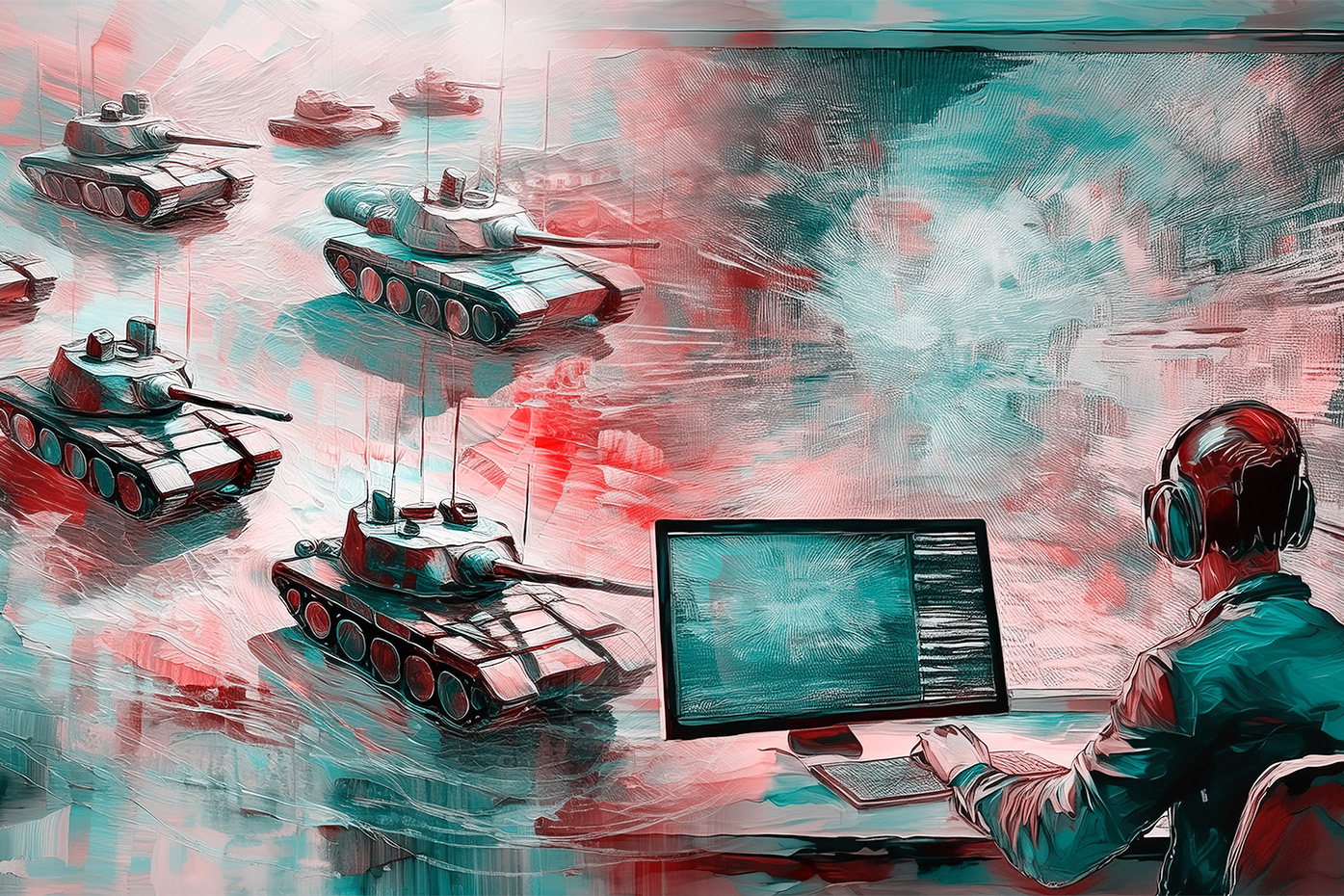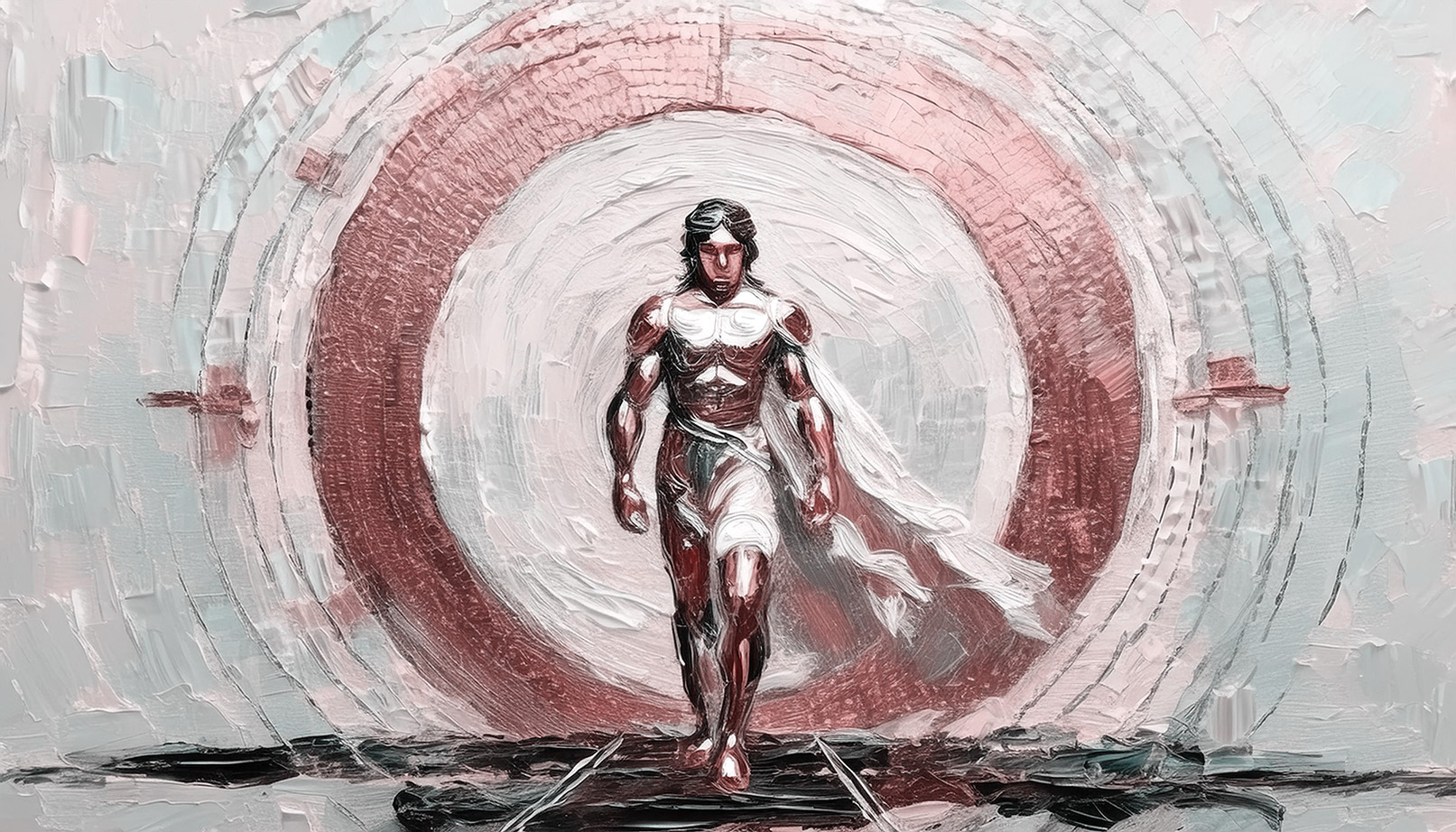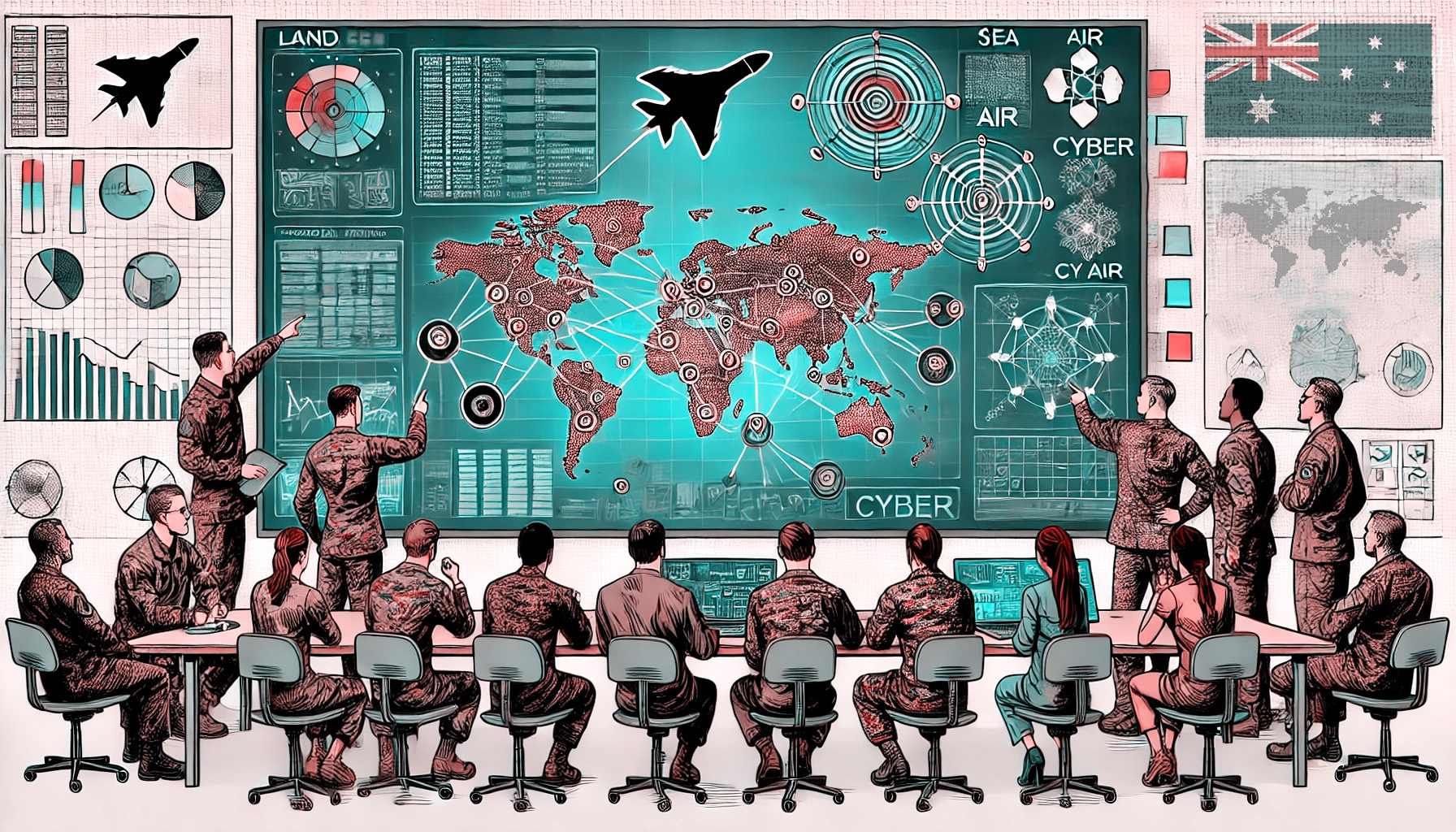Introduction
The ADF’s Operational Framework comprises eight elements, including Simultaneity, Main and Supporting Efforts and Assessment, through which military actions are arranged into executable courses of action (COA). Alongside the framework of Operational Design, this forms the concept of Operational Art, which develops operations and campaigns by integrating capabilities, synchronising their employment, and orchestrating their conduct for the purpose of achieving strategic objectives. However, the applicability of this framework is increasingly limited because of the impact emergent information considerations have on the character of war.
The ADF’s operational framework is intended to link tactical actions to strategic objectives. However, this contrasts with its preference to distinguish between kinetic actions (such as using physical force) and non-kinetic actions (such as public affairs and electronic warfare). This places undue emphasis on the former in a manner incongruent with the realities of the information-dominated operational environment—moreover, the absence of any unifying operational narrative results in tactical actions that are incoherent with the strategic objective. By comparison, malign actors such as Russia have been far more proficient at coherently arranging military actions in this environment. Whereas the ADF’s Operational Framework was intended to bridge strategy with tactics, this environment demands it bridge words and deeds.
First, this essay will develop an understanding of the ADF’s Operational Framework within the context of Operational Art, examining its applicability in the contemporary operating environment. Second, it will undertake a comparative analysis between the ADF’s Framework and the Russian arrangement framework of ‘Reflexive Control’, demonstrating the advantage of malign actors in integrating, synchronising, and orchestrating kinetic and non-kinetic actions to achieve influencing and coercive strategic objectives. Finally, it will propose the inclusion of a Unified Operational Narrative as a ninth element to arrange military action in a manner coherent with the strategic narrative.
1. The ADF Operational Framework
Understanding the ADF Operational Framework
According to ADF-P-5 Planning, the ADF's Operational Framework comprises eight elements that guide the Arrangement of Military Action into executable COA.[1] The Arrangement of Military Action and the additional framework of Operational Design comprise the overarching concept of Operational Art, which the ADF defines as 'the skilful employment of military forces to attain strategic goals through the design, organisation, sequencing and direction of campaigns and major operations’. Operational Art ‘translates strategic into operational and, ultimately, tactical actions'[2] through integration, synchronisation and orchestration.[3] Integration refers to the selection of the appropriate combination of informational and physical effects to influence behaviour; orchestration refers to the vertical cohesion of actions across the tactical, operational and strategic levels of war, and synchronisation arranges the combination of orchestrated effects in terms of timing, tempo, scope and intensity.[4]
The ADF uses the Joint Military Appreciation Process (JMAP) as a structured framework to apply the two concepts of Operational Art.[5] Operational Design conforms to the first two steps of the JMAP—Scoping and Framing and Mission Analysis—allowing staff to use the art of war to frame the problem to be solved and design a broad theory of victory. The Arrangement of Military Action relates to the final three steps of the JMAP: COA Development, COA Analysis and Decision and Concept of Operations (CONOP) Development.[6] The Arrangement of Military Action applies the science of war to structure problem solving and allows for the development and analysis of several COAs. These are distinguished based on the eight elements of Risk, Culminating Point, Operational Reach, Sequencing, Phasing, Main and Supporting Efforts, Branches and Sequels, and Assessment.[7] The development of this detail is intended to ensure military actions are integrated, orchestrated and synchronised appropriately.[8]
Notwithstanding the violent nature of war, military actions are fundamentally about influencing the decisions of adversaries, allies, neutrals and civilian populations.[9] The ADF framework, which plans and integrates relevant effects to achieve this influence by projecting the thoughts of planners 'forward in time to identify how to influence an actor' is Operational Art, underpinned by the two foundational concepts of Operational Design and the Arrangement of Military Action.[10] This framework is intended to identify actors that need influencing, which behaviours need changing, develop methods of influencing decision making to achieve that change, and then synchronise 'kinetic and non-kinetic actions and lethal and non-lethal effects of military power towards a unified narrative that seeks to change adversary thinking and behaviour'.[11] However, since the ADF adopted Operational Art, the character of war has continued to evolve, rendering the existing framework for arranging military action less applicable for integrating, synchronising and orchestrating effects to influence the adversary through kinetic and non-kinetic means.
The Changing Operating Environment
Since adopting Operational Art in the ADF, the character of war has continued to evolve, necessitating its continual review to ensure its applicability and appropriateness to the ADF's operational context. Operational Art is a concept that resulted from post-industrial revolution warfare, whereby armies' growing size, mobility, dispersal and lethality rendered it impossible to achieve victory in war through a single decisive battle.[12] Modern Operational Art, as we know it in Australia, emerged from this foundation.[13] However, contemporary operating environments are now significantly shaped by considerations such as the ubiquity, hyperconnectivity and exponential growth of information.[14] Whereas the expanded scale of post-industrial revolution warfare necessitated the adoption of Operational Art to manage the increasing gulf between strategy and tactics, these information considerations have the obverse effect, allowing for the compression of the battlespace in time and space and leading to a greater interrelationship between the levels of war.[15] Such compression amplifies incoherence between the tactical action and the overarching strategic narrative.[16] Lethality and combat power alone are now inadequate mechanisms to achieve victory.[17]
Perceptions of military actions in war are becoming increasingly fractured as belligerents and actors fight over different meanings of the same events in real time.[18] The virality, persuasiveness and prominence of narratives are now decisive in victory and defeat.[19] However, the ADF's approach to the arrangement of military action remains firmly grounded in contemporary conceptions of Operational Art as a means of linking strategy and tactics, emphasising the application of physical force and manoeuvre above information considerations. Australia's failure to adapt its Operational Framework to contemporary circumstances featured prominently in the recent report on key organisational lessons from the Afghanistan campaign. Opaque national objectives resulted in a divergence of strategic narratives and tactical action. [20] The ADF's Operational Framework failed to bridge this gap, resulting in incoherent tactical actions and poorly communicated and understood narratives.[21]
By comparison, Australia's global competitors have often been far more effective at integrating, orchestrating and synchronising information and military operations through mass media, adroitly exploiting the information environment to offset relative disadvantages in conventional military strength while targeting the legal and cultural seams of liberal democratic societies.[22] China and Russia are typical of malign actors who exploit information power for their advantage.[23] Compared to the ADF's Operational Framework, the Russian framework of Reflexive Control provides an alternative approach whereby informational ends, ways and means are placed at the forefront of planning and are, therefore, better able to adapt to the informational considerations of the operational environment.[24] Reflexive Control is a systematic process whereby adversary perceptions are deliberately shaped, influencing them to voluntarily act in a way conducive to Russia's strategic interests.[25] This concept has existed in Soviet military literature since the 1970s when systems thinking and game theory rose to prominence as a way to exploit biases and influence the actions of opponents based on reflex.[26]
As an arrangement framework, Reflexive Control has broad applicability across the tactical to strategic levels.[27] In a manner analogous to Western Operational Art, Reflexive Control guides the integrated application of information and physical effects orchestrated for a unified purpose and synchronised in terms of location, time and target audience.[28] However, whereas the ADF Operational Framework seeks to arrange military actions to defeat an adversary's centre of gravity to defeat their plan, Reflexive Control seeks to employ physical and non-physical means to shape perceptions of the operating environment and affect the opponent's decision-making system to influence them to change their plan voluntarily.[29] From 2014–2022, Russia applied this framework to operations in Ukraine, effectively influencing the US and its NATO allies to adopt a passive approach to Russia's application of physical and non-physical power in the Donbas region.[30]
2. A Comparative Analysis of the ADF Operational Framework and Russian Reflexive Control
A comparative analysis of the ADF's Operational Framework for arranging military action and the Russian framework of Reflexive Control reveals that, compared to Russia, the ADF is deficient in its ability to integrate kinetic and non-kinetic effects, synchronise physical and information actions and orchestrate military action through a unified operational narrative. Elements of the ADF’s process for arranging military action will be compared with Reflexive Control for each point.
The Integration of Military Actions
First, the ADF Operational Framework views kinetic and non-kinetic actions in contrasting rather than unified terms, neglecting the informational impacts of physical actions. The Arrangement of Military Action, particularly the element of Simultaneity, describes kinetic and non-kinetic actions as separate activities requiring integration.[31] While they can be mutually supportive, they are also considered as alternatives to one another. Moreover, the Main and Supporting Efforts element distinguishes between typical combat-oriented capabilities and non-kinetic ones.[32] Finally, the ADF Framework’s element of Assessment goes so far as to establish a specific metric for information activities and behavioural change—measures of impact—separate from measures of effect, which relate to objectives and outcomes.[33] This distinction between kinetic and non-kinetic actions is enshrined in the ADF's consolidation of information capabilities under the rubric of Information Operations, encouraging the divergence of physical and non-physical actions. This distinction ignores that 'all military activities have inherent informational aspects' that affect adversary perceptions of the operational environment.[34] Since physical power can have informational effects and information capabilities can influence the physical environment, separating the two into kinetic and non-kinetic buckets appears increasingly illogical.[35]
Russian military theorists have viewed Reflexive Control as an additional method for implementing Operational Art.[36] However, compared to Western frameworks, such as the ADF’s, Reflexive Control is strongly oriented towards selecting and arranging physical and informational actions precisely for their information effect. Within Reflexive Control, military actions are selected and combined to create a particular stimulus in the opponent's mind to influence them to undertake an action reflexively.[37] These actions, analogous to decisive points in the parlance of ADF-P-5, are referred to as 'information packets' based on the perception and reflex they are intended to initiate.[38] These information packets, which include the non-verbal messages of physical actions, provide the inputs into the enemy's decision-making sequence to influence them to change their plans voluntarily.[39] These physical actions can include displays of superior force alongside psychological operations, explicit and implicit threats, feints and deception.[40] Both combat and information actions are viewed as mechanisms through which information can be transferred to an enemy and affect their perception of what appears feasible and predictable, influencing their hasty but voluntary action.[41] Thus, rather than viewing kinetic and non-kinetic operations in contrasting terms, such as ADF-P-5's Arrangement of Military Action, Reflexive Control considers both physical and non-physical actions in unified terms from the perceptions they can create in the minds of an adversary.
The Synchronisation of Military Actions
Where the ADF Operational Framework does make limited mention of non-kinetic actions, it does so only in terms that place it in a supporting, rather than decisive, role. Quite explicitly, when the Arrangement of Military Action addresses the element of the Main and Supporting Efforts, it details non-kinetic activities as a supporting effort or efforts alongside other 'enabling forces, such as logistics, engineering, [and] joint fires'[42]. This implies that typical actions relating to physical manoeuvre are considered decisive, whereas non-physical actions are not and are therefore not prioritised for resourcing.[43] While this approach is directed at the vulnerabilities of an adversary centre of gravity, these vulnerabilities represent targets for what is typically kinetic action. This continued implicit emphasis on physical and kinetic capabilities appears incongruent with the achievement of influencing and coercive effects. The reduced emphasis on information capabilities is typical of Western militaries, where calls for 'information campaigns' to support military campaigns are typical, despite information being integral to (rather than separate from) military campaigning.[44] More broadly, the continued supporting role of Information Operations has seen it regarded as a marginal activity and a failing enterprise.[45] Information considerations, including critical areas such as military deception, are an afterthought or band-aid to planning rather than an integral element.[46]
Compared to ADF-P-5, where information actions are synchronised in support of physical actions, Reflexive Control adopts the obverse approach, viewing physical actions as an additional mechanism to communicate non-verbal messages in support of cognitive effects. These actions are intended to convey motives and reasoning to a susceptible target to influence them to change their plans voluntarily.[47] Denial and deception are placed at the forefront of planning at every level of warfare.[48] This deception is the primary goal of Reflexive Control, with the decisive element being a change to adversary decision making rather than destroying a particular asset.[49] Considering adversary vulnerabilities is critical to this process, specific vulnerabilities within their sensing, understanding and decision-making systems.[50] In applying Operational Art, particularly the Arrangement of Military Actions and selecting the Main and Supporting efforts, all means should be considered equal.[51]
The Orchestration of Military Actions
The ADF Operational Framework offers no unified operational narrative to integrate words and deeds and to align military actions with the overarching strategic narrative. ADF doctrine, including elements of ADF-P-5, stresses the importance of a narrative to unify kinetic and non-kinetic actions to achieve influencing and coercive effects, noting that without the fusion of these actions, ADF activity will 'appear disjointed', implying a requirement to ensure the alignment of words and deeds.[52] In considering the element of Simultaneity, integrating kinetic and non-kinetic actions is necessary to 'present a narrative’, or 'story', that either influences or coerces the adversary'.[53] However, ADF-P-5 fails to outline where and how the narrative should be derived and how it would be integrated into Operational Art to arrange these actions coherently. ADF-P-3 Campaigns and Operations, when examining the campaign process and developing the campaign concept, does detail that nuanced narratives are required for each target audience to be derived from 'strategic guidance'.[54] However, in either case, there needs to be recognition of the absence of narrative development from the ADF's framework of Operational Art in ADF-P-5. Narratives in ADF-P-5 are considered in terms of declaratory problem statements and commander's guidance.[55] Whereas Operational Art is intended to link tactical actions with strategic objectives, the absence of any description of how narratives relate to the commander's intent and the planning framework robs any coherence between tactical actions and the strategic narrative.[56] The framework needs more details regarding the analysis, development, integration and dissemination of unifying operational narratives.[57] Thus, a significant doctrinal gap exists in ADF-P-5 in orchestrating military action in the contemporary operating environment.
Reflexive Control links Russian strategy, operations and tactics by disguising Russia's activities abroad, systematically denying its open use of military force for malign purposes, deriving legitimacy from its military successes, and providing spurious legal rationales for action when a degree of transparency is unavoidable.[58] While Western frameworks aspire (but mostly fail) to align words and actions through a coherent narrative, the Russian approach seeks to sever the connection between physical reality and effective cognition to confuse the information environment regarding Russian actions.[59] Rather than providing clarity on Russian actions, Reflexive Control intends to create a 'hallucinating fog of war' that contributes to misdirection, deception, indecision or entire decision paralysis by employing physical and non-physical actions to alter perceptions of Russia's strategic intent.[60] Such an approach challenges the ability of Western militaries to accurately identify the Russian centre of gravity (despite employing a highly centralised decision-making architecture optimised for orchestration) while increasing the entropy and chaos of the operational environment.[61] Rather than offering a unifying narrative, Russian Reflexive Control offers various narratives orchestrating tactical actions with strategic intent.
3. Recommendations
Including the Operational Narrative in the Arrangement of Military Action
The ADF's Operational Framework is deficient in its ability to arrange military action to integrate kinetic and non-kinetic actions to support a unifying narrative, deleteriously affecting its operations in an increasingly complex operating environment. Comparatively, Russia’s arrangement framework of Reflexive Control has demonstrated significant advantages in integrating, synchronising and orchestrating kinetic and non-kinetic military actions. However, its emphasis on deception and the overall fracturing and degradation of the information environment is not replicable by the ADF with its emphasis on moral legitimacy and trust. Nonetheless, it has been recognised that the ADF can apply additional methodologies alongside its existing planning framework to deal with 'wicked problems'.[62] Adapting to this environment would require an evolutionary, rather than revolutionary, approach to dealing with the function of information of war.[63] Specifically, by adding a ninth element to the Arrangement of Military Action, an 'operational narrative', commanders could better link multiple decisive actions by time, space and audience.[64] A narrative is a collection of stories with a beginning, middle and end that explain an organisational mission's rationale, present a future vision, and explain how that vision will be achieved.[65] These stories 'share common themes, forms, events and participants through which recipients interpret and frame events.[66]
Narratives can be divided by levels, which are interlinked and nested. A master narrative spans a broad population, local narratives are limited to a specific geographic context, and personal narratives are the stories told by individuals that provide coherence with the local and master narratives. These levels are broadly analogous to war's strategic, operational and tactical levels.[67] Operational narratives are a necessary addition to the Arrangement of Military Actions for several reasons, including to meet the requirements of the contemporary information environment, guard against the ethnocentrism of the strategic war narrative, exploit human heuristics to interpret information and add meaning to events through stories, and to compete with adversary narratives.[68] The development of operational narratives would be possible by considering the commander's intent, the conduct of narrative and cultural analysis, and the deliberate integration of kinetic and non-kinetic actions, placing informational considerations at the forefront of planning.[69] The distinct tailoring of operational narratives to specific and relevant populations through the Arrangement of Military Action allows for the development of distinct COA, with relevant populations effectively representing separate lines of operation whose perception is shaped by successive integrated physical and information actions progressing towards a final end state. Including an operational narrative allows for developing the three critical areas related to the Arrangement of Military Action, specifically integration, orchestration, and synchronisation.
Conclusion
The changing character of the contemporary operating environment is now testing the applicability of the ADF’s Operational Framework. Frameworks that arrange military action without due consideration for the information impacts of physical action and in a manner inconsistent with the strategic narrative will now have their incoherence punished with increasing severity. While the ADF’s framework does make limited reference to the integration of kinetic and non-kinetic actions in the elements of Simultaneity, Main and Supporting Efforts and Assessment, it ultimately lacks a unified operational narrative to cohere tactical action in support of strategic objectives. By comparison, the Russian arrangement framework of Reflexive Control places information at the forefront of planning, employing kinetic and non-kinetic actions to exploit the characteristics of the information environment and successfully achieve strategic influencing and coercive effects. Including a unified operational narrative in the ADF’s arrangement framework would enhance its ability to integrate, synchronise and orchestrate kinetic and non-kinetic actions in a manner consistent with the strategic narrative.
Buckel, Chad. ‘A New Look at Operational Art: How We View War Dictates How We Fight It’. Joint Force Quarterly 100 (2021).
Campbell, Angus J. ADF-C-0 Australian Military Power. 1st ed. ADF Capstone Doctrine. Australian Defence Force, 2021.
———. ADF-P-3 Campaigns and Operations. 3rd ed. ADF Philosophical Doctrine 3. Canberra, ACT: Directorate of Information, Graphics and eResources Lessons and Doctrine Directorate, 2023.
———. ADF-P-5 Planning. 1st ed. ADF Philosophical Doctrine, 5 Series. Directorate of Information, Graphics and eResources Lessons and Doctrine Directorate, 2021.
Chase, Maj Steven R. ‘Reframing Operational Art for Competition’. Military Review March-April 2023 (April 2023): 20–28.
Cicalese, Carmine. ‘Redefining Information Operations’. Joint Force Quarterly 2nd Quarter 2013, no. 68 (2013): 109–12.
Crabb, Andrew L. ‘Toward Military Design: Six Ways the JP 5-0’s Operational Design Falls Short’. Joint Force Quarterly, no. 105 (Quarter 2022): 99–104.
Elder, Robert J. ‘Information Maneuver in Military Operations’. Strategic Multilayer Assessment. George Mason University, August 2021.
Hocking, Andrew. ‘Preparing for the Future: Key Organisational Lessons from the Afghanistan Campaign’. Occasional Paper. The Vanguard. Canberra, ACT: Centre for Defence Research, Australian Defence College, March 2022.
Hoskins, Andrew, and Pavel Shchelin. ‘The War Feed: Digital War in Plain Sight’. American Behavioral Scientist 67, no. 3 (1 March 2023): 449–63.
Hunerwadel, John P. ‘Planning to Win: A Study in Strategy and Operational Art’. Chronicles Online Journal, 27 February 2002.
Jackson, Aaron P. ‘A Tale of Two Designs: Developing the Australian Defence Force’s Latest Iteration of Its Joint Operations Planning Doctrine’. Journal of Military & Strategic Studies 17, no. 4 (January 2017): 174–93.
———. ‘Innovative within the Paradigm: The Evolution of the Australian Defence Force’s Joint Operational Art’. Security Challenges 13, no. 1 (2017): 59–80.
Kasapoglu, Can. ‘Russia’s Renewed Military Thinking: Non-Linear Warfare and Reflexive Control’. Research Paper. Rome, Italy: NATO Defense College, November 2015.
Lawniczak, Brent A. ‘The Narrative Policy Framework in Military Planning’. Joint Forces Quarterly, no. 108 (Quarter 2023): 21–28.
Livieratos, Cole. ‘Bombs, Not Broadcasts: U.S. Preference for Kinetic Strategy in Asymmetric Conflict’. Joint Force Quarterly, no. 90 (Quarter 2018).
McGurk, Marshall. ‘Factors Influencing Strategy: The Objective-Narrative Nexus’. The Strategy Bridge (blog), 31 August 2023. https://thestrategybridge.org/the-bridge/2023/8/31/factors-influencing-strategy-the-objective-narrative-nexus.
Meier, MAJ Benjamin. ‘The Operational Narrative in Wars of Choice’. SAMS Monograph, US Army War College, 2016.
Metz, Thomas F, and James E Hutton. ‘Massing Effects in the Information Domain: A Case Study in Aggressive Information Operations’. Military Review May-June 2006 (June 2006): 2–12.
Mulgund, Dr Sandeep, and Gen Mark Kelly. ‘Command and Control of Operations in the Information Environment: Leading with Information in Operational Planning, Execution, and Assessment’. Air and Space Power Journal, Senior Leader Perspective, Winter 2020, 15–26.
Nissen, Thomas Elkjer. ‘Narrative Led Operations’. Militært Tidsskrift 141, no. 4 (January 2013): 67–77.
Quinn, Tyler, and Von Lambert. ‘Musings on the Prominence of Informational Effects in the Operational Art’. Grounded Curiosity (blog), 20 May 2018. https://groundedcuriosity.com/musings-on-the-prominence-of-informational-effects-in-the-operational-art/.
Reese, Travis. ‘Operations in the Information Environment: Application of the Direct and Indirect Approach For’. Marine Corps Gazette, August 2020, 31–39.
Shaikh, Sohail A, and Robert D Payne. ‘Narrative in the Operations Process (Invited Paper)’. Application/pdf, 2014, 7 pages.
The Cove. ‘Cove Clips | MAJGEN Hocking on the Afghanistan Campaign’. Accessed 21 October 2023. https://cove.army.gov.au/article/cove-clips-majgen-hocking-afghanistan-campaign.
Thomas, Timothy. ‘Russia’s “New” Military Theory: Updating Classical and Asymmetric Techniques’. Technical Report. McLean, VA: The MITRE Corporation, 1 January 2020.
———. ‘Russia’s Reflexive Control Theory and the Military’. The Journal of Slavic Military Studies 17, no. 2 (1 June 2004): 237–56.
———. ‘Russia’s Reflexive Control Theory: Manipulating an Opponent to One’s Advantage’. Technical Report. McLean, VA: The MITRE Corporation, June 2019. h
Thomson, Scott K, and Christopher E Paul. ‘Paradigm Change: Operational Art and the Information Joint Function’. Joint Force Quarterly 2nd Quarter 2018 (2018): 8–14.
Tuner, Bunyamin. ‘Information Operations in Strategic, Operational, and Tactical Levels of War: A Balanced Systematic Approach’. Naval Postgraduate School, 2003.
1 Angus J Campbell, ADF-P-5 Planning, 1st ed., ADF Philosophical Doctrine, 5 Series (Directorate of Information, Graphics and eResources Lessons and Doctrine Directorate, 2021), 55.
2 Angus J Campbell, ADF-P-3 Campaigns and Operations, 3rd ed., ADF Philosophical Doctrine 3 (Canberra, ACT: Directorate of Information, Graphics and eResources Lessons and Doctrine Directorate, 2023).
3 Campbell, ADF-P-3 Campaigns and Operations, 14.
4 Campbell, ADF-P-5 Planning, 34; Dr Sandeep Mulgund and Gen Mark Kelly, ‘Command and Control of Operations in the Information Environment: Leading with Information in Operational Planning, Execution, and Assessment’, Air and Space Power Journal, Senior Leader Perspective, Winter 2020, 24.
5 Campbell, ADF-P-5 Planning, 73.
6 Aaron P Jackson, ‘Innovative within the Paradigm: The Evolution of the Australian Defence Force’s Joint Operational Art’, Security Challenges 13, no. 1 (2017): 70.
7 Jackson, 69.
8 Jackson, 68.
9 Angus J Campbell, ADF-C-0 Australian Military Power, 1st ed., ADF Capstone Doctrine (Australian Defence Force, 2021), 1.
10 Campbell, ADF-P-5 Planning, 13.
11 Campbell, 5.
12 Chad Buckel, ‘A New Look at Operational Art: How We View War Dictates How We Fight It’, Joint Force Quarterly 100 (2021): 95.
13 Bunyamin Tuner, ‘Information Operations in Strategic, Operational, and Tactical Levels of War: A Balanced Systematic Approach’ (Monterey, California, Naval Postgraduate School, 2003), 45.
14 Travis Reese, ‘Operations in the Information Environment: Application of the Direct and Indirect Approach For’, Marine Corps Gazette, August 2020, 31.
15 Tuner, ‘Information Operations in Strategic, Operational, and Tactical Levels of War: A Balanced Systematic Approach’, 29.
16 Buckel, ‘A New Look at Operational Art: How We View War Dictates How We Fight It’, 96.
17 Thomas Elkjer Nissen, ‘Narrative Led Operations’, Militært Tidsskrift 141, no. 4 (January 2013): 68.
18 Andrew Hoskins and Pavel Shchelin, ‘The War Feed: Digital War in Plain Sight’, American Behavioral Scientist 67, no. 3 (1 March 2023): 459.
19 Brent A Lawniczak, ‘The Narrative Policy Framework in Military Planning’, Joint Forces Quarterly, no. 108 (Quarter 2023): 1.
20 ‘Cove Clips | MAJGEN Hocking on the Afghanistan Campaign’, The Cove, accessed 21 October 2023, https://cove.army.gov.au/article/cove-clips-majgen-hocking-afghanistan-campaign; Andrew Hocking, ‘Preparing for the Future: Key Organisational Lessons from the Afghanistan Campaign’, Occasional Paper, The Vanguard (Canberra, ACT: Centre for Defence Research, Australian Defence College, March 2022), 16.
21 Hocking, 23.
22 Thomas F Metz and James E Hutton, ‘Massing Effects in the Information Domain: A Case Study in Aggressive Information Operations’, Military Review May-June 2006 (June 2006): 5; Cole Livieratos, ‘Bombs, Not Broadcasts: U.S. Preference for Kinetic Strategy in Asymmetric Conflict’, Joint Force Quarterly, no. 90 (Quarter 2018): 65; Robert J Elder, ‘Information Maneuver in Military Operations’, Strategic Multilayer Assessment (George Mason University, August 2021), 14.
23 Scott K Thomson and Christopher E Paul, ‘Paradigm Change: Operational Art and the Information Joint Function’, Joint Force Quarterly 2nd Quarter 2018 (2018): 9.
24 Can Kasapoglu, ‘Russia’s Renewed Military Thinking: Non-Linear Warfare and Reflexive Control’, Research Paper (Rome, Italy: NATO Defense College, November 2015), 2.
25 Kasapoglu, 2.
26 Timothy Thomas, ‘Russia’s Reflexive Control Theory and the Military’, The Journal of Slavic Military Studies 17, no. 2 (1 June 2004): 238.
27 Timothy Thomas, ‘Russia’s Reflexive Control Theory: Manipulating an Opponent to One’s Advantage’, Technical Report (McLean, VA: The MITRE Corporation, June 2019), 3.
28 Thomas, ‘Russia’s Reflexive Control Theory and the Military’, 244.
29 Thomas, ‘Russia’s Reflexive Control Theory: Manipulating an Opponent to One’s Advantage’, 4.
30 Elder, ‘Information Maneuver in Military Operations’, 7.
31 Campbell, ADF-P-5 Planning, 60.
32 Campbell, 62.
33 Campbell, 65.
34 Thomson and Paul, ‘Paradigm Change: Operational Art and the Information Joint Function’, 11.
35 Thomson and Paul, 11.
36 Thomas, ‘Russia’s Reflexive Control Theory: Manipulating an Opponent to One’s Advantage’, 5.
37 Thomas, 3.
38 Thomas, 11.
39 Kasapoglu, ‘Russia’s Renewed Military Thinking’, 5.
40 Thomas, ‘Russia’s Reflexive Control Theory and the Military’, 244.
41 Thomas, 245.
42 Campbell, ADF-P-5 Planning, 62.
43 Thomson and Paul, ‘Paradigm Change: Operational Art and the Information Joint Function’, 11.
44 Carmine Cicalese, ‘Redefining Information Operations’, Joint Force Quarterly 2nd Quarter 2013, no. 68 (2013): 110.
45 Thomson and Paul, ‘Paradigm Change: Operational Art and the Information Joint Function’, 11.
46 Andrew L Crabb, ‘Toward Military Design: Six Ways the JP 5-0’s Operational Design Falls Short’, Joint Force Quarterly, no. 105 (Quarter 2022): 4.
47 Thomas, ‘Russia’s Reflexive Control Theory and the Military’, 241.
48 Crabb, ‘Toward Military Design’, 4.
49 Thomas, ‘Russia’s Reflexive Control Theory and the Military’, 237.
50 Timothy Thomas, ‘Russia’s “New” Military Theory: Updating Classical and Asymmetric Techniques’, Technical Report (McLean, VA: The MITRE Corporation, 1 January 2020), 2.
51 Nissen, ‘Narrative Led Operations’, 76.
52 Campbell, ADF-P-5 Planning, 87.
53 Campbell, 60.
54 Campbell, ADF-P-3 Campaigns and Operations, 78.
55 Campbell, ADF-P-5 Planning, 21.
56 Nissen, ‘Narrative Led Operations’, 74.
57 Lawniczak, ‘The Narrative Policy Framework in Military Planning’, 3.
58 Kasapoglu, ‘Russia’s Renewed Military Thinking’, 5, 12.
59 Kasapoglu, 6.
60 Kasapoglu, 6.
61 Kasapoglu, 4.
62 Aaron P Jackson, ‘A Tale of Two Designs: Developing the Australian Defence Force’s Latest Iteration of Its Joint Operations Planning Doctrine’, Journal of Military & Strategic Studies 17, no. 4 (January 2017): 192.
63 Reese, ‘Operations in the Information Environment: Application of the Direct and Indirect Approach For’, 31.
64 Marshall McGurk, ‘Factors Influencing Strategy: The Objective-Narrative Nexus’, The Strategy Bridge (blog), 31 August 2023, https://thestrategybridge.org/the-bridge/2023/8/31/factors-influencing-strategy-the-objective-narrative-nexus.
65 Nissen, ‘Narrative Led Operations’, 70.
66 Nissen, 71.
67 Sohail A Shaikh and Robert D Payne, ‘Narrative in the Operations Process (Invited Paper)’, application/pdf, 2014, 4,https://doi.org/10.4230/OASICS.CMN.2014.2.
68 Tyler Quinn and Von Lambert, ‘Musings on the Prominence of Informational Effects in the Operational Art’, Grounded Curiosity (blog), 20 May 2018, https://groundedcuriosity.com/musings-on-the-prominence-of-informational-effects-in-the-operational-art/; John. P Hunerwadel, ‘Planning to Win: A Study in Strategy and Operational Art’, Chronicles Online Journal, 27 February 2002, 6; Nissen, ‘Narrative Led Operations’, 68.
69 MAJ Benjamin Meier, ‘The Operational Narrative in Wars of Choice’ (SAMS Monograph, Fort Leavenworth, Kansas, US Army War College, 2016), 39; Lawniczak, ‘The Narrative Policy Framework in Military Planning’, 6; Maj Steven R Chase, ‘Reframing Operational Art for Competition’, Military Review March-April 2023 (April 2023): 22; Nissen, ‘Narrative Led Operations’, 75.









Comments
Start the conversation by sharing your thoughts! Please login to comment. If you don't yet have an account registration is quick and easy.